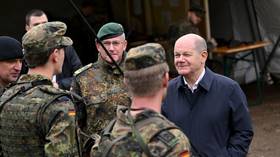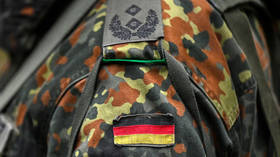Scholz broke promises to German military – NYT

Chancellor Olaf Scholz’s €100 billion ($109 billion) cash injection into the German military has yet to reach the rank and file, where soldiers told the New York Times that they still lack weapons, ammunition, and working toilets.
Within days of Russian troops entering Ukraine last February, Scholz announced that his government would set up a €100 billion fund to modernize Germany’s military, and would increase defense spending to meet the 2% of GDP threshold mandated by NATO.
The world was at a “Zeitenwende” (historic turning point), he said, in a speech that marked a radical departure from the post-Cold War malaise that saw the military stripped of funding and – by the time of Angela Merkel’s final term in office – short on working vehicles, ammunition, food, and even boots.
However, the NYT reported on Wednesday, the “Zeitenwende” is “rarely visible to rank-and-file soldiers who still lack even the most ordinary infrastructure, ammunition and equipment.”
At the German military’s artillery school, training exercises are routinely canceled due to a lack of ammunition, and troops have yet to receive replacements for 14 howitzers that were shipped to Ukraine, the newspaper reported. Renovations to the school’s buildings have been postponed until 2042, meaning that soldiers will have to deal with broken windows, leaking roofs, and toilets in such a state of disrepair that they were permanently shut last year.
Although the army commissioned its first new artillery battalion in October, it now has only five such battalions, compared to 83 at the height of the Cold War. Likewise, while Germany plans on increasing the number of active-duty personnel to just over 200,000 by 2030, it had almost half a million men in uniform during the Cold War.
Furthermore, the procurement of new weapons promised by Scholz has been stalled by German bureaucracy. For any purchase requests of more than €5,000 ($5,490), military personnel must submit a request to a civilian-run procurement office, where staff were previously known to take years to complete orders.
Amid the rush to arm Ukraine, supplies of weapons and ammunition remain low, and by the time production catches up, inflation will have raised their purchase price and devalued Scholz’s €100 billion investment.
“We are witnesses of a deception,” former Colonel Roderich Kiesewetter told the newspaper.
The NYT is not the first newspaper to notice that the “Zeitenwende” has been mostly smoke and mirrors. As opposition politicians accused Scholz of “breaking a promise” to the military last November, soldiers told The Telegraph that personnel from other NATO forces mock their outdated radios on joint exercises. By this February, it was reported that less than a third of the €100 billion war chest had been assigned to contracts, and Berlin has failed to meet its 2% defense spending goal in 2022 and 2023.
Should Germany’s military revitalization continue at its current pace, parliamentary commissioner Eva Hogl wrote in a report earlier this year, “it would take about half a century before just the current infrastructure of the [military] was completely renovated.”














